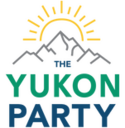Yukon Party facts for kids
Quick facts for kids
Yukon Party
Parti du Yukon
|
|
|---|---|
 |
|
| Leader | Currie Dixon |
| President | Melanie Brais |
| Founded | 1978 |
| Headquarters | Whitehorse, YT |
| Membership (2020) | 1,577 |
| Ideology | Conservatism Yukon regionalism Provincehood |
| Political position | Centre-right |
| Colours | Blue |
| Seats in Legislature |
8 / 19
|
The Yukon Party, once known as the Yukon Progressive Conservative Party, is a political group in Yukon, Canada. It follows a conservative way of thinking. This means they often believe in keeping traditions and having less government involvement in the economy.
Contents
History of the Yukon Party
Early Days and First Leaders
The Yukon Progressive Conservative Party started in April 1978. A long-time Yukon politician named Hilda Watson became its first leader. She won by just one vote against Erik Nielsen. Hilda Watson had been part of the Legislative Council since 1970. She was the first woman in Canadian history to lead a political party into an election. However, she did not win a seat in the 1978 election and stepped down. Chris Pearson then took over as leader and joined the government.
Changing Names and New Challenges
The Progressive Conservatives lost the 1985 election to the Yukon New Democratic Party (NDP). At that time, the federal Progressive Conservative Party, led by Prime Minister Brian Mulroney, was not very popular. Because of this, the Yukon Progressive Conservatives decided to separate from the federal party. They changed their name to the "Yukon Party" before the 1992 election.
The first leadership vote for the new Yukon Party happened in June 1991. Chris Young, who was 21 and used to lead the youth group, won. But soon after, two politicians, Bea Firth and Alan Nordling, left the party. They started their own group called the Independent Alliance Party.
By August, Chris Young resigned as leader. He felt that Yukon voters might not support a party led by someone so young and new to politics. John Ostashek then became the leader in November. He was the only person running for the job.
Winning and Losing Elections
The Yukon Party won the 1992 election. John Ostashek became the Premier of Yukon, which is like the head of the government for the territory. His government was a "minority government." This means they did not win more than half of the seats. However, Nordling, Firth, and Willard Phelps, who were independent politicians, agreed to support the Yukon Party.
Ostashek's government became unpopular because they raised taxes and cut some services. The party lost the 1996 election to the NDP. They only won three seats and ended up in third place, behind the Yukon Liberal Party for the first time. In that election, Nordling rejoined the Yukon Party but did not win his seat. Firth retired from politics.
The 2000s and Beyond
The party's success continued to drop in the 2000 election. The Yukon Party won only one seat. Many voters who usually supported right-leaning parties chose the Yukon Liberal Party instead. This put the Liberals in power for the first time in Yukon's history.
However, the Liberal government, led by Premier Pat Duncan, faced problems. Even though they had won a majority of seats, some members left or resigned. This made them a "minority government" within two years. Premier Duncan called an early election in November 2002 to try and win back her majority. But this plan did not work out.
The Yukon Party had chosen Dennis Fentie as its new leader in June 2002. Fentie was a Member of the Yukon Legislative Assembly (MLA) from a rural area. He had previously been with the Yukon New Democratic Party (NDP). Even though the election was called suddenly, the Yukon Party won a "majority government" with 12 seats. The NDP won five seats, and the Liberals were left with only one. Fentie became the second Yukon Premier from a rural area.
On October 10, 2006, the Yukon Party won again, holding 10 seats in the Legislative Assembly. The Yukon Liberals won five seats, and the Yukon New Democrats won three.
The party lost the 2016 Yukon general election and became the Official Opposition. This means they were the main party opposing the government.
Currie Dixon led the party into the 2021 Yukon general election. The Yukon Party won 8 seats and received the most votes overall. Dixon himself was elected in the area of Copperbelt North. On April 23, 2021, the Liberals, who were already in power, were sworn in with a "minority government." A few days later, on April 28, the NDP announced they would support the Liberals in a formal "confidence and supply" agreement. This means the NDP agreed to vote with the Liberals on important issues, allowing the Liberal government to stay in power.
Leaders of the Yukon Party
- Hilda Watson – 1978
- Chris Pearson – 1978–1979 (interim), 1978–1985
- Willard Phelps – 1985–1991
- Chris Young – 1991
- John Ostashek – 1991–2000
- Peter Jenkins – 2000–2002 (interim)
- Dennis Fentie – 2002–2011
- Darrell Pasloski – 2011–2016
- Stacey Hassard - 2016–2020 (interim)
- Currie Dixon – 2020–present
See also
- List of premiers of Yukon
- List of Yukon Leaders of Opposition

